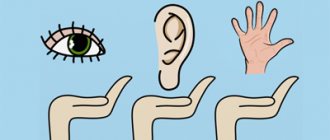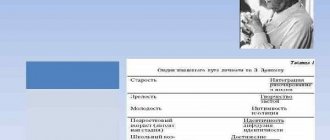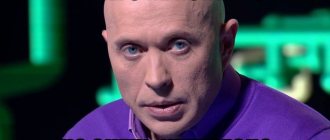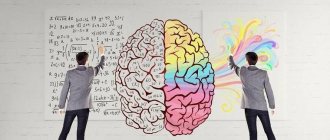The brain is the main organ of the central nervous system, which consists of a huge number of nerve cells and their processes, interconnected. This organ almost completely occupies the cavity of the cerebral part of the skull. It provides protection to the brain from external damage. As a person develops and matures, the brain gradually takes the shape of the skull.
Due to the activity of the brain, a person sees, hears, walks, works, experiences emotions, is able to communicate with other people, analyze, and think.
Structure
In adult men and women, the total mass of the organ is about 1.3-1.5 kg. The male and female brains differ little in weight (in women it is slightly lighter), while in newborns the weight of the organ is no more than 350-400 g, and in a 12-year-old child - ~800-1000 g. The brain is located in the cranium and is closed by three shells. It has a specific structure. The most significant parts of the organ are: the medulla oblongata and the posterior (which includes the pons and the cerebellum, located behind the pons), the forebrain, the diencephalon, and the midbrain.
The right and left hemispheres of the brain are responsible for regulating higher nervous activity, because they contain departments that are responsible for writing, speech, hearing, and vision. Thanks to the cerebellum, balance is ensured, and the trunk contains developed centers that control the respiratory and cardiovascular systems.
In men, the brain completely stops growing in size around the age of 25, while in women this process is completed by the age of 15.
Between the two halves of the organ there is a longitudinal fissure, the basis of which is the corpus callosum, connecting the hemispheres, ensuring coordination of their work with each other. Since school times, we have known from anatomy that the halves are responsible for the work of opposite sides of the body. For example, the right half is responsible for the functioning of the left side of the body.
Causes of left-handedness
There are various reasons for left-handedness, on which the development of certain qualities in a child may depend.
- Genetic left-handedness.
Left-handedness is 10-12 times more common in families in which at least one of the parents is left-handed
- “Compensatory” left-handedness associated with any damage to the brain, most often to the left hemisphere in the event of any injury or illness at an early stage of the child’s development
- “Forced” left-handedness . The choice of the dominant hand in such left-handers is usually associated with an injury to the right hand, but can also be the result of imitation of family or friends.
- pseudo-left-handedness in children does not develop a dominant hemisphere in relation to the hand. Then pseudo-left-handedness is observed or, what happens more often, approximately equal use of both hands.
Functions of the left hemisphere
The hemispheres of the brain are interconnected with the rest of the central nervous system, therefore they function together with subcortical structures.
If one of the hemispheres is damaged, then the other may take over part of its functions. This indicates the associated support for the functioning of movements, higher nervous activity, sensitivity, and sensory organs.
The cortex has several zones that are responsible for performing specific functions. These zones only work together. For example, if a person wants to say something, then he thinks, analyzes, calculates, and then only speaks. In the process of communication, people express emotions: they are sad, happy, worried, laughing, etc., they gesture, using their facial muscles and hands. Such work is ensured by the general functioning of:
- several zones of the cortex;
- subcortical nuclei;
- spinal and cranial nerves.
At the moment, less than 50% of the human brain has been studied by world science, but the process continues continuously.
Is it worth retraining left-handed children?
To prevent even such doubts, I would like to remind you once again that we are talking not only about the leading hand, but about a certain organization of the brain . By retraining left-handedness, we are unsuccessfully trying to remake the biological nature of the child.
It should be understood that by forcing a child to write with his right hand, we are not able to change the leading hemisphere.
Therefore, the consequences of retraining can be: disturbances in the tempo and rhythm of speech (according to statistics, every third child with a stutter is a retrained left-hander), serious changes in the emotional state of the child (he can become hot-tempered, capricious, irritable, sleep restlessly, eat poorly). Later, even more serious disorders appear: frequent headaches, constant lethargy. As a result, neurotic reactions develop, for example, nervous tics, enuresis, or the functional state of the neuropsychic sphere is disrupted, i.e. neurosis develops, for example, writer's cramp.
Retrained left-handers may have various neurological manifestations: disturbances in appetite and sleep, fears, enuresis (urinary incontinence), tics, stuttering, indigestion, irritability, sudden changes in mood, motion sickness in transport.
Manifestations of neuroses in left-handed children were studied separately :
- Asthenic neurosis. Symptoms of this type of neurosis are manifested in the following: increased fatigue, exhaustion of the nervous system, a sharp decrease in performance. Physically, children can work actively only in the first two lessons, and then it is very difficult to awaken their attention, but then motor disinhibition occurs. Preparing lessons at home usually takes a long time, and the results are unsatisfactory. Written assignments are especially difficult to complete. The handwriting is unstable (letters of different sizes, different inclinations, the line is not followed, many additional strokes, corrections).
- Obsessive-compulsive neurosis. This type of neurosis manifests itself in families where parents are anxious about left-handedness and believe that it can serve as an obstacle in later life. If parents force their children to perform all actions with their right hand, they usually obey and try, even though it turns out poorly. Parents very often see this as disobedience, caprice, stubbornness and punish. Such children develop an anxious expectation of failure, and subsequently develop obsessive thoughts about their inferiority. Such children are quite often worried about school fears of failure and written work.
- Neurotic enuresis. In most cases, only nocturnal enuresis is observed, but it can also occur during the day. Enuresis causes feelings of guilt and fear of punishment. Performance decreases even more, the child cannot concentrate, and a vicious circle is formed.
- Neurotic tics. Tics include: blinking, lip licking, forehead wrinkling, nose twitching. Such phenomena rarely cause excitement and concern among parents. The child does not control these movements. Tics are not directly related to performing tasks with the right hand, but intensify when the child is tired or nervous.
Speech motor area
Allows you to ensure the normal functioning of the facial muscles, which is necessary for pronouncing complex phrases and words. To put it differently, thanks to the speech motor area, speech is formed in a person as a whole. If he is right-handed, then in the left hemisphere the speech motor zone takes up much more space than in the right, and if he is left-handed, everything is exactly the opposite.
If the zone is destroyed or severely damaged, the ability to speak is automatically lost. In this case, a person will be able to sing and scream without words. Also, if damaged, the ability to read to oneself and formulate one’s thoughts is lost. Such damage does not affect the function of understanding the speech of other people.
There is a common myth that a person uses only 5-10% of his brain capacity. This is not true, because cells that are not used simply die.
Characteristics of right-hemisphere thinking
A person whose right-hemisphere thinking predominates often uses an intuitive approach to solving life problems and professional tasks. Such a person uses logic in situations of extreme necessity. For a right-brain person, high ideals and moral guidelines are valuable; he is inclined to philosophize. The “artist” does not like it when someone controls him: he prefers to act on his own initiative. For a right-brain person, relationships with others are important. Such a person is capable of generating unique ideas, creating something new and beautiful.
It must be said that the classical education system is designed to develop predominantly left-hemisphere thinking, almost completely ignoring the development of right-hemisphere skills. This is expressed in the fact that children and students are taught only to memorize and reproduce information within the framework of the curriculum, at most to think logically, and very little attention is paid to the development of imaginative thinking, imagination, fantasy, intuition, and creativity. Unfortunately, right-brain, creative thinking is not cultivated in traditional educational institutions and, as a result, students become ordinary “standard” adults. This approach significantly limits the process of personality development and makes it one-sided.
Motor area
The left and right hemispheres contain the motor cortex, which is necessary to ensure the activity of the striated muscles. In the left hemisphere, the activity of the right side of the body, coordination of precise movements, and orientation on the ground are controlled. The internal organs send their impulses to this zone.
If the motor cortex is damaged, the following problems will occur:
- disturbances in the functioning of the cardiovascular system and respiratory organs;
- paresis of limbs;
- ataxia.
How do you know which hemisphere is dominant?
You can find out which hemisphere is dominant with the help of special tests. And the easiest way to find out is to listen to yourself. If you rely on intuition when making decisions, if you trust your feelings and sensations, if you do not particularly strive for leadership and human resource management, if music can evoke emotions in you, and films can evoke strong emotions, then your right hemisphere activity predominates. If you like to be a leader and organizer, it is not difficult for you to make a convincing speech, you tend to analyze any problem, breaking it down into its components - you have a left-hemisphere type of thinking.
Occipital lobe
At the base of the brain, visual and auditory fibers intersect. Therefore, the visual zone of the left hemisphere receives impulses from the retina of the right and left eyes. Moreover, if the area is damaged, the person will not experience complete blindness - disturbances are observed only in the left eye.
The back of the head is also necessary to ensure the normal functioning of the visual speech center - with its help we recognize written words and letters and read.
Why develop right-brain thinking?
Many scientists have emphasized the special value of right-hemisphere thinking. One of the founders of scientific pedagogy, the German researcher Johann Friedrich Herbart noted that a bad teacher presents the truth, while a good teacher teaches to find it. Neuropedagogist Natalia Traugott said that “the educational system needs to be warned against left-hemisphere education, as this produces people who will not be able to carry out real actions in real situations.” Professor T. P. Khrizman lamented that “right-hemisphere people—generators of ideas—are disappearing. The question is serious: we need to save the nation.”
“An experiment in the field of pedagogy and psychology conducted by American, Swiss and Austrian scientists showed that schoolchildren began to excel significantly in all disciplines when the regular school curriculum was reduced by increasing the hours of music lessons.”
Recently, the issue of intensive development of right-hemisphere thinking has become topical. For example, the ability to think imaginatively and comprehensively, and quickly generate ideas are the most important skills of a modern top manager, who often works in conditions of chaos and stress. The largest companies - banks, retailers, manufacturers - do not neglect the development of intuitive-sensory thinking of their employees, including management. Therefore, right-brain thinking should be developed in order to succeed and improve the quality of life.
Cortex
Cortex
is the outer layer of the brain, or gray matter.
In humans, the gray matter has an uneven surface with many folds. Ridges called gyri
and folds called
sulci
help increase the surface area of the cerebral cortex.
The cerebral cortex contains four main lobes:
- frontal lobe
- parietal lobe
- occipital lobe
- temporal lobe
Since the hemispheres do not have clearly defined divisions, neuroscientists divide the lobes conditionally on the basis of grooves.
Central sulcus
(lat. sulcus centralis cerebri) is also known as the Rolandic fissure - a large groove in the cerebral cortex that separates the frontal lobe from the parietal lobe.
Precentral gyrus
— is located in front of the central sulcus, which neuroscientists use to identify the primary motor cortex of the brain.
Postcentral gyrus
— is located just behind the central sulcus, which neuroscientists use to identify the primary somatosensory cortex of the brain.
Lateral sulcus
- separates the temporal lobe from the frontal and parietal lobes.
Superior temporal gyrus
- located below the lateral sulcus, where the brain receives and processes information.
Fifth beat
, called
the insula,
is located inside the lateral sulcus.
Exercises to activate the right hemisphere
"Recommendation. Intuition, internal imaginative vision, an integrated approach - all these manifestations of right-hemisphere thinking can be developed. You can do this either independently (using the well-known methods of Heinrich Altshuller, Edward de Bono, Michael Mikalko, Tony Buzan, Julia Cameron, Merilee Zdenek and others), or you can do intensive creativity training in a group at a special training.”
Start training the right hemisphere with simple exercises that are performed in pairs.
- Exercise "Images". Sit comfortably and close your eyes. Concentrate on your breathing: breathe deeply, becoming more calm with each breath and focusing on your own sensations. Inhale and exhale easily and freely. Feel that you are warm, cozy, comfortable and that you are breathing in clean, fresh and cool air. This way you calm down and get ready for a new type of activity. Now your partner will slowly read out the words that you need to feel, feel as realistically as possible. Focus on the content of the words. Say the words to yourself and imagine what you hear in your imagination.
First, visual images : banana, river, forest, flower, bee, red, game, affectionate, tinker, weave.
Next are auditory images : the sound of the sea, the sound of a moving tram, the sounds of a piano, the ringing of a bell, gusts of wind, falling drops, chirping sparrows, echo, whisper.
Bodily images : stroking fur, melting snowflake, warm steam, walking on a soft carpet, hot water, sharp needle, fish scales, soft fluff.
And in the end - olfactory and tactile images : the aroma of a fresh rose, the smell of hay, the smell of pine needles, the taste of a freshly cut orange, a slice of chocolate, a canapé with large red caviar.
- Exercise "Proverbs". Your exercise partner makes a wish for some well-known proverb or saying and tries to explain silently, non-verbally (only with the help of facial expressions and gestures) what he wished for. You're guessing. Then you switch roles.
Good luck in developing right-brain thinking! Your opinion: how is right-hemisphere, intuitive-imaginative thinking related to leadership?
Author: Oksana Sedashova
We also recommend reading:
- Storytelling
- Brain structure
- Intelligence and its development: several recommendations
- How does thinking work?
- Brain development: useful tips and exercises
- Digest: critical thinking
- Development of thinking: ways to train the brain
- How and why to develop thinking
- Types of thinking
- Creativity and logic: the myth of functional asymmetry of the cerebral hemispheres
- Logic vs intuition
Key words:1Cognitive science
Diagnostics
When a patient with signs of a stroke comes to the Yusupov Hospital, specialists strive to accurately determine the state of blood flow in the brain vessels of the right hemisphere. The first priority in complex diagnostics are visualization methods: CT and MRI, which make it possible to establish the localization of the lesion, the type and subtype of stroke, and also determine which vessel pathology led to disruption of brain nutrition.
With ischemic stroke, a “mismatch” phenomenon occurs, which can be detected during perfusion CT. A feature of this condition is that with a decrease in blood volume and the speed of its movement, an ischemic penumbra zone appears. This area of the brain contains cells whose death can be prevented.
Comprehensive diagnosis of ischemic stroke of the right hemisphere at the Yusupov Hospital is carried out using high-precision methods:
- cerebral angiography is prescribed to patients if surgical intervention is necessary;
- transcranial Doppler sonography is carried out to study the state of blood flow in the brain;
- electroencephalography is used to establish areas of subcortical and cortical damage;
- Positron emission tomography and scintigraphy are performed to assess the nature of brain metabolism.
Other structures located in the cerebral hemispheres
Arteries
The brain contains arteries to supply the brain with blood, which are divided into anterior, middle and posterior branches. Each branch helps supply blood to different areas of the hemisphere.
Olfactory bulb
The olfactory bulb, located under the frontal lobe, delivers information directly to the cerebral cortex for interpretation.
Amygdala
The amygdala is a major component of the limbic system. It controls automatic reactions such as the fight or flight response.
Hippocampus
A structure within the temporal lobe, the hippocampus plays a role in learning and memory.










